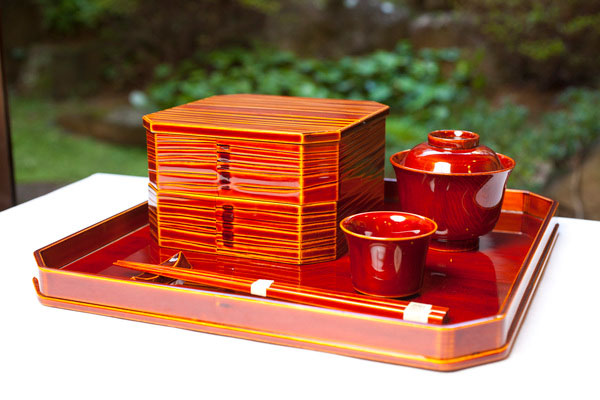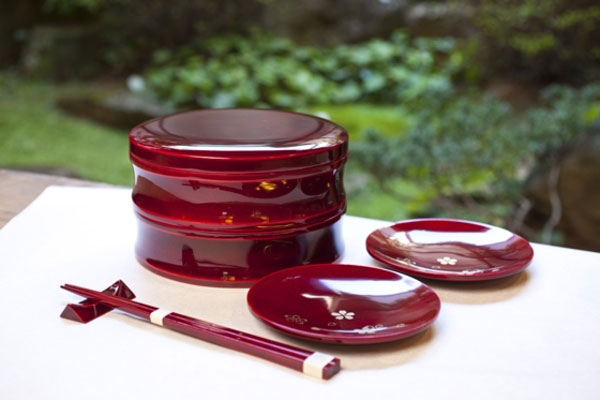 Photo:Gifu Prefecture
Photo:Gifu Prefecture
- Lacquerware
- Gifu
Hida-shunkei lacquerware Hida shunkei
Simplicity of the wood grain
Austere and clear beauty
Description
What is Hida-shunkei lacquerware ?
Hida-shunkei lacquerware is produced around the city of Takayama in Gifu prefecture. The name is said to come from the fact that the articles produced initially had a similar coloring to Hishunkei tea containers.
This craft is notable for having an interwoven harmony between the simple beauty of its natural wood grain and the characteristically clear lacquer. It can also be said that Hida-shunkei lacquerware pursues practical beauty, as its color and luster become more pronounced through use. Items include daily necessities such as trays, flower vases, stacked boxes, and tea utensils.
Hida-shunkei lacquerware's impressive color is a secret guarded by lacquer artisans who each have their own unique formulas for the clear lacquer. Therefore, the color tone varies in subtle ways depending on the lacquering master.
History
 Photo:Gifu Prefecture
Photo:Gifu Prefecture
At the beginning of the 17th century, a master carpenter named Kizaemon TAKAHASHI was struck by the beauty of the wood grain of sawara cypress trees, and produced a tray using this wood. He then presented it to Sowa, the older brother of the lord of the Takayama domain. Hida-shunkei lacquerware is said to have begun when Sowa, who took a liking to this tray, asked the lacquering master San-emon NARITA to coat it with lacquer.
The coloring of this tray was similar to "Hishunkei tea container", a masterpiece by Kagemasa KATO who is a potter from the Kamakura period (1185-1333), so it was called Shunkei lacquerware and presented to the family positioned to be the next shogunate (feudal military government).
Then, this natural woodgrained craft was mainly used for tea utensils, after which many articles for daily use like stacked boxes and trays started to be produced. In the Meiji (1868-1912) and Taisho (1912-1926) periods, the lacquerware industry was promoted mainly by wholesalers, who exhibited their wares at World Fairs overseas, and Hida-shunkei lacquerware became well-known as a result.
Although there was a decline during World War II due to the difficulty in obtaining lacquer, during the postwar period of rapid economic growth this craft became widely given as a gift. In recent years demand has been increasing for Hida-shunkei lacquerware as souvenirs for tourists.
General Production Process
- 1. Wood
The woods used in Hida-shunkei lacquerware include hinoki cypress, sawara cypress, and Japanese horse chestnut. Wood that has been naturally and thoroughly dried over the course of five to six years is made into wood bases with a woodturner. After being piled up in the open and naturally dried, the pieces are processed into portable sheets at a sawmill.
- 2. Natural drying
The sheets are piled up, dried, and further dried inside a storehouse.
- 3. Sawing and timber conversion
The wood is cut into boards to suit the shapes of products.
- 4. Wood base production
Depending on the type of product, specialized hegimeshi, magemonoshi, or hikimonoshi woodturners will produce the wood base.
For hegimeshi, the wood grain is made into hegime (grooves that are carved out between the wood grains) and parts are combined together to form rectangular boxes and trays. Nikawa glue (an adhesive produced by heating water together with animal skin and bones) is used to join boards together.
Magemonoshi is when wooden boards that have been softened by steaming are curved to produce lunchboxes, tea canisters, and inkstone cases with rounded corners. Forms are produced using a wooden roller known as a koro, and both ends are attached with nikawa glue and then reinforced by binding with hill cherry barks.
Lastly, for hikimonoshi, wood is placed on a lathe and hand planed with a sharp blade while rotating to produce circular pieces (trays, sweets containers, and tea saucers).
- 5. Filling
The finished wood grain is delivered to a lacquer specialist.
After polishing the unpainted wood, polishing powder (fine-grained clay) is mixed with water, coated on the wood, then wiped off with a cloth. This ensures that the coating of lacquer is even and that colors stay during coloring. This is said to be the most important of all processes because it evens out the surface of the unpainted wood.
- 6. Coloring
Color is applied with yellow or red dyes.
- 7. Undercoating
Gojiru, a soybean paste, is applied several times to produce a thin membrane that prevents lacquer from suddenly permeating the wood base.
- 8. Finishing and polishing
The surface of the wood base is polished with sandpaper.
- 9. Lacquering
After applying a mixture of raw lacquer and egoma oil (vegetable oil) to the wood base, it is wiped off with a cloth and the wood base is soaked with lacquer. The lacquer hardens and becomes transparent. This step is repeated many times, changing the surface appearance of the wood grain.
- 10. Overcoating
The wood base is finished with a clear lacquer overcoat. Overcoating is applied with great care, as it can be ruined by dirt and dust. The lacquer used for overcoating is produced by lacquering masters using a secret recipe, each having their own ways of purifying raw lacquer. Also, since lacquer hardens and dries at a fixed humidity and temperature, different lacquers are used depending on the day and season.
- 11. Drying
Items are placed in a drying room known as a furo, which is like a large closet, and dried with the proper temperature and humidity levels.
Where to Buy & More Information
Kamioka Hida Shunkei Center
-
Address
-
Tel.+81-577-32-3373
-
ClosedDecember 31 & January 1 only
-
Business HoursApril to October 8am to 5:30pm November to March 9am to 5pm
-
Website
See more Lacquerware
- Wajima lacquerware
- Kamakura-bori lacquerware
- Tsugaru lacquerware
- Aizu lacquerware
- Yamanaka lacquerware
- Kawatsura lacquerware
- Echizen lacquerware
- Joboji lacquerware
- Kiso lacquerware
- Hidehira lacquerware
- Kagawa lacquerware
- Ryukyu lacquerware
- Takaoka lacquerware
- Wakasa lacquerware
- Hida-shunkei lacquerware
- Ouchi lacquerware
- Kanazawa lacquerware
- Kishu lacquerware
- Kyo laquerware
- Odawara lacquerware
- Naruko lacquerware
- Niigata lacquerware
- Murakami carved lacquerware































































































































































































































































































